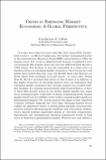Artículo
Crises in emerging market economies: a global perspective
Fecha
2008Resumen
It is now more than ten years since the “first crisis of the twentyfirst century,” as Michel Camdessus, the former managing director of the International Monetary Fund (IMF), called Mexico’s 1994–95 tequila crisis. The event is important not because it signaled a new environment (the tequila crisis was not that different from Mexico’s 1982 crisis), but because it was the beginning of a long series of financial crises in emerging market economies. Their frequency and global span (Latin America, Asia, the Middle East, and Russia) set them apart from anything seen previously—at least since World War II. The key question that arises in this respect is as follows: is the higher frequency of emerging market crises an indication that emerging market economies have become sharply less creditworthy (for example, by running unsustainably large fiscal deficits), or does it show that greater access to the global capital market has made these economies more vulnerable to shocks originating in the capital market itself? In Calvo (2002), I refer to these capital market shocks as globalization hazard.
Colecciones
Descargar


